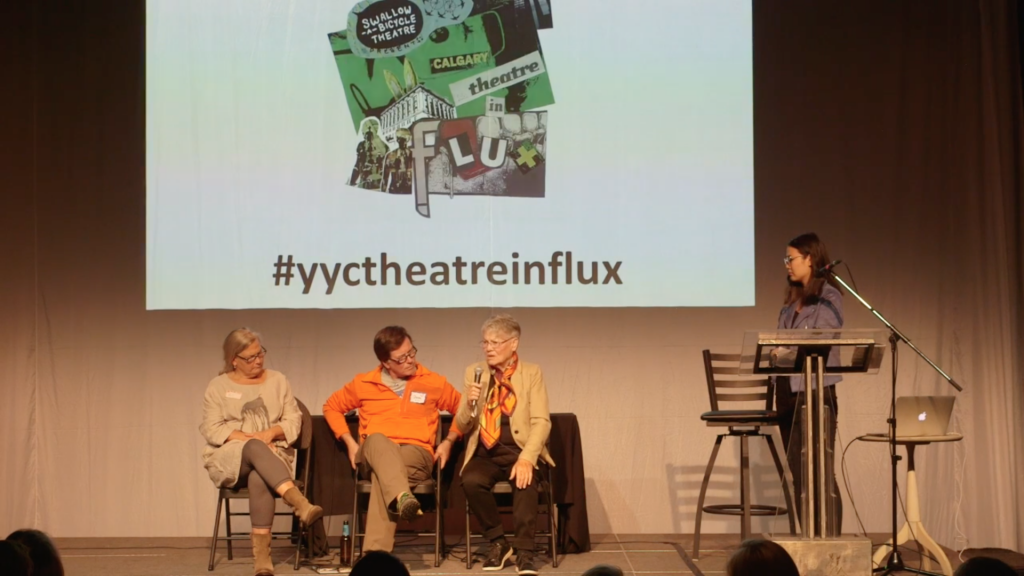
It’s been a turbulent year for Calgary theatre—and that’s being generous.
From 2017-2018, the Calgary arts community has been beset by funding cutbacks in private donations and public grants, sudden radical shifts brought about by the #MeToo movement, losses in arts journalism including the decision by PostMedia to cease publication of Swerve Magazine, and stunning social media frenzies around Alberta Theatre Projects and Theatre Junction Grand.
Operating in these challenges, arts organizations are grasping for ways to change, but before they truly begin that work, there has to be a foundational work to build upon. Mark Hopkins and Swallow-a-Bicycle Theatre (SAB) decided to start the conversation by hosting “Theatre in Flux: a forum about our future”.
Hopkins referred to the current economic and social environment in his intro on September 9, when representatives from Calgary’s theatre companies gathered in the Vertigo Studio to hear from panelists and presenters on where their community might be headed.
The arts are going through growing pains, with new voices calling for greater representation for people of colour on stage and off, along with subscription models becoming a possible thing of the past. In the shadow of a rapidly evolving global geo-political reality (largely tilted towards the rise of alt-right fascism), theatres are also searching their souls for how to tackle sensitive topics and issues. Do artists charge headlong into controversy, like the cast of Hamilton reading Mike Pence a personal message? Or, like Robert LePage, do they simply shrug off the criticisms of politically active audience members and critics, seeking new audiences that agree with the messages they want on stage?
As Hopkins aptly observed early on in the event, “Frankly, we’re not going to get to everything… I’m hoping this is going to be the first—or not even the first—one in a continuity of ongoing conversations.”
This is without doubt the only fair lens to apply to SAB’s Theatre in Flux event; a first or one of many in a series of gatherings that perhaps can help the performing arts world understand where it is, where it came from, and where it might need to go. Indeed, the scheduled agenda was just that: a series of conversations and conversation starters, with panelists and presenters. In many cases, these segments did have the impression of being very “raw,” like the first steps in a recipe, but with only some mild clues as to what is being cooked up.

Take, for instance, Emiko Muraki, until recently employed at the Calgary Arts Development Authority (CADA), who presented the early findings of a recent questionnaire—one of the first of its kind conducted in the community—on equity and diversity reporting in the arts. As she intimated at the beginning of her presentation, Muraki cautioned that the findings were not altogether surprising, not yet refined by thorough analysis, and did not include arts workers outside of theatre, and of those theatre companies only those organizations funded by Calgary Arts Development were represented. Reporting was voluntary, not mandatory, and relied on organizations either completing the survey on behalf of all of their employees, or asking employees to complete and submit the survey themselves.
What’s important, however, is that this questionnaire was undertaken at all. While the data paints an at-best incomplete and flawed snapshot of the Calgary arts community, it nevertheless shows that across every breakdown, Calgary’s theatres do not employ a significant number of people of colour.
Studies like this are vital to the future actions of arts organizations. The foundational importance of CADA’s study is validating voices that say more representation is needed. It is all well and good for organizations to pay lip service to the progressive attitudes of inclusion with token roles for people of colour on or offstage, but it is far more important to nail down both how to address the issue and why it is important. This, then, would be how the conversation should proceed from this particular “first,” to a place of responding to the now-validated concerns of artists of colour.
“Firsts” has a double meaning for the panelists who made up the next segment of the evening, “Theatre in Context,” featuring Valerie Planche, Duval Lang, and Sharon Pollock. Together these three artists represented some of Calgary’s first generation of professional theatre makers. Calgary, and many other Canadian cities, have a comparatively short history of professional performing arts when weighed against the lengthy histories of America, Europe, and Asia. In Calgary’s case the professional companies trace their origins back only 50-60 years years, depending on how far into the amateur side of societies you go. This panel is, in fact, an opportunity: to have a conversation bridging the current generation’s concerns with the concerns of those artists who are now well-established or even are retiring. Another first.
For the second group of panelists, Jenna Rodgers, Justin Many Fingers, and Stafford Arima, “first” is a term for pioneering in their respective fields. Arima is Theatre Calgary’s first person of colour to hold the Artistic Director’s seat. Many Fingers is the youngest artistic leader in Making Treaty 7’s history. And Rodgers and her company Chromatic Theatre are currently tracking YYC Theatre Stats, a first for accountability and reporting in the city’s makeup (going beyond the depth of CADA’s groundwork). As was aptly observed by Rodgers during the panel, simply putting together a panel entirely composed of people of colour is something of a rarity. Hearing the perspectives of people directly involved in topics of representation isn’t just useful, it’s absolutely necessary.

So the question, then, is this: from “first conversation” where do you go next?
A two-hour discussion trying to cover all of these issues is only ever going to scratch surface. Yet fundamentally, one cannot address a problem without first identifying which problems exist. Hopkins is right that this forum is “part of a continuity,” though in this case the ongoing continuity would be to take the broad situation and focus in on the specific. From firsts, there must be action. From the greater picture, there must be small, intimate details.
For SAB’s event, these details came at the end, in a series of slides read out by Hopkins. “Pay living wages.” “Offer feedback. Receive feedback.” “Have a workplace harassment policy.” These items blazed by in under 10 minutes, compared to the lengthy, 30+ minute panel discussions. Unfortunately, the brevity of this final presentation undercut its importance: that from conversation we must pivot to action.
Perhaps it’s impatient to expect said action to come quickly. That may, in fact, be the forum’s greatest achievement: creating hunger for more conversation, more action, and more firsts.









